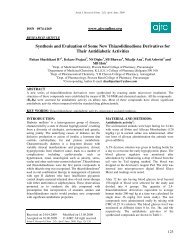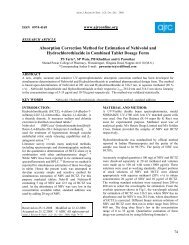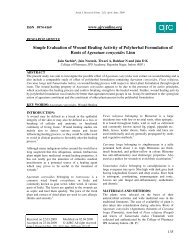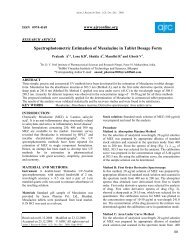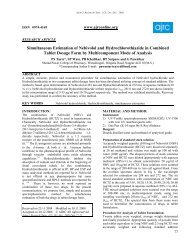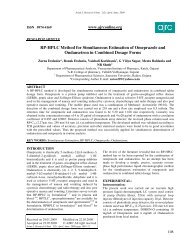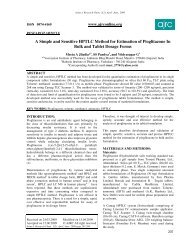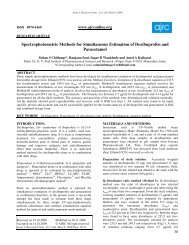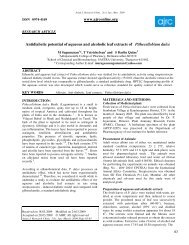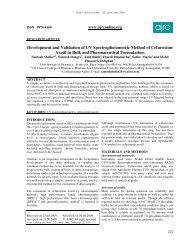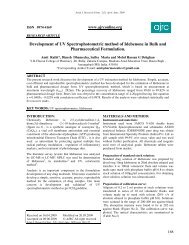Issue-4_April - Asian Journal of Research in Chemistry (AJRC)
Issue-4_April - Asian Journal of Research in Chemistry (AJRC)
Issue-4_April - Asian Journal of Research in Chemistry (AJRC)
Create successful ePaper yourself
Turn your PDF publications into a flip-book with our unique Google optimized e-Paper software.
Abstract<br />
RESEARCH ARTICLE<br />
Quantification <strong>of</strong> Quercet<strong>in</strong> and Rut<strong>in</strong> <strong>in</strong> Ashwagandharishta by Validated HPTLC Densitometry<br />
Preeti Tiwari 1 * and Rakesh K. Patel 2 ……………………………………………………………………………………….441<br />
1 Department <strong>of</strong> Pharmacognosy, Shri Sarvajanik Pharmacy College, Mehsana-384001, India.<br />
2 Head <strong>of</strong> Department <strong>of</strong> Pharmacognosy, Shri S. K. Patel College <strong>of</strong> Pharmaceutical Education and <strong>Research</strong>,<br />
Kherva-382711, India<br />
ABSTRACT:<br />
Ashwagandharishta is a polyherbal hydro-alcoholic formulation and is used as immunomodulator to promote the<br />
health and longevity by <strong>in</strong>creas<strong>in</strong>g defence aga<strong>in</strong>st disease and also known for its usefulness <strong>in</strong> the treatment <strong>of</strong><br />
hypercholesterolemia. A simple, precise and accurate HPTLC method has been established for the determ<strong>in</strong>ation <strong>of</strong><br />
quercet<strong>in</strong> and rut<strong>in</strong> <strong>in</strong> Ashwagandharishta–T and Ashwagandharishta-M prepared by traditional and modern<br />
methods respectively and also <strong>in</strong> its marketed formulation. The developed HPTLC method was validated <strong>in</strong> terms <strong>of</strong><br />
precision, accuracy, LOD, LOQ and specificity. The amount <strong>of</strong> quercet<strong>in</strong> <strong>in</strong> Ashwagandharishta-T, M and its<br />
marketed formulation was found to be 0.0021, 0.00192 and 0.00197 % w/w respectively while rut<strong>in</strong> was found to be<br />
0.00469, 0.00441 and 0.00464 % w/w respectively. This is the first report for the quantification <strong>of</strong> quercet<strong>in</strong> and<br />
rut<strong>in</strong> <strong>in</strong> Ashwagandharishta by HPTLC. Furthermore, no TLC densitometric methods have been reported for the<br />
quantification <strong>of</strong> quercet<strong>in</strong> and rut<strong>in</strong> from Ashwagandharishta.<br />
Modulation <strong>of</strong> Clonazepam Solubility us<strong>in</strong>g Solid Dispersion Technique Improves its Solubility and<br />
Bioavailability.<br />
Hanaa A. Fattah 1 , Hammad M. A. 1 , Nagia El-Megrab 1 , Waleed Barakat 2 , Ahmed Samir 1 ………………………446<br />
1 Department <strong>of</strong> Pharmaceutics, Faculty <strong>of</strong> Pharmacy, Zagazig University, Egypt.<br />
2 Department <strong>of</strong> Pharmacology, Faculty <strong>of</strong> Pharmacy, Zagazig University, Egypt.<br />
ABSTRACT:<br />
The pharmacologic efficacy <strong>of</strong> benzodiazep<strong>in</strong>es (as clonazepam, CZP) <strong>in</strong> controll<strong>in</strong>g seizures is directly associated<br />
with their plasma concentration. An emergent epileptic situation necessitates rapid drug absorption. parentral<br />
adm<strong>in</strong>istration is not convenient <strong>in</strong> epileptic emergency and oral bioavailability <strong>of</strong> CZP is limited by its poor water<br />
solubility.<br />
Solid dispersion formulations were developed by physical mixture and solvent evaporation us<strong>in</strong>g CZP with the<br />
carriers polyv<strong>in</strong>yl pyrrolidone K30 (PVP K30, 1:4) or polyethylene glycol 4000 (PEG 4000, 1:4).<br />
Analysis <strong>of</strong> the solid dispersions by FTIR, DSC, XRD and dissolution studies showed that CZP was molecularly<br />
dispersed <strong>in</strong> an amorphous form and <strong>in</strong>dicate <strong>in</strong>creased dissolution rate.<br />
In addition, the oral bioavailability <strong>of</strong> the formulations was significantly improved reach<strong>in</strong>g therapeutic levels with<strong>in</strong><br />
30 and 60 m<strong>in</strong> <strong>in</strong> case <strong>of</strong> PEG 4000 and PVP K30 respectively follow<strong>in</strong>g oral adm<strong>in</strong>istration to mice.<br />
In conclusion; PVP K 30 and PEG 4000 can be utilized to <strong>in</strong>crease the solubility <strong>of</strong> CZP and enhance its oral<br />
bioavailability.<br />
Use <strong>of</strong> Activated Carbon <strong>of</strong> Thevetia peruviana wood for the Adsorption <strong>of</strong> Acid Violet Dye from Aqueous<br />
Solutions<br />
J. Raffiea Baseri 1 , P.N. Palanisamy 2 and P. Sivakumar 3 ………………………………………………………………..456<br />
1 Department <strong>of</strong> <strong>Chemistry</strong>, Al-Ameen Eng<strong>in</strong>eer<strong>in</strong>g College, Erode, Tamilnadu-638 104, India<br />
2 Department <strong>of</strong> <strong>Chemistry</strong>, Kongu Eng<strong>in</strong>eer<strong>in</strong>g College, Perundurai, Erode, Tamilnadu- 638 052,India<br />
3 Department <strong>of</strong> <strong>Chemistry</strong>, Arignar Anna Government Arts College, Namakkal, Tamilnadu- 637 002, India





